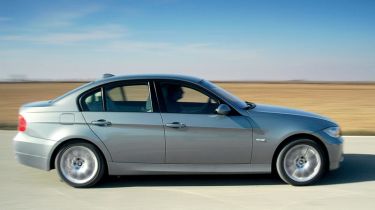BMW 3-Series
Do not underestimate the importance of this car. Possibly the most crucial model to be launched in 2005, the new BMW 3-Series is now entering its fifth generation. Not a bad way to celebrate your 30th birthday!
BMW has done exactly what was needed. The 3-Series is smoother, larger and more refined, yet driver appeal hasn't been diluted. Only the cabin design disappoints - it's still not as user-friendly as top rivals.
Do not underestimate the importance of this car. Possibly the most crucial model to be launched in 2005, the new BMW 3-Series is now entering its fifth generation. Not a bad way to celebrate your 30th birthday!
It has plenty to boast about, too. Besides the new look - admittedly toned down from the more extravagant appearance of the German company's 5 and 7-Series - the 3-Series has a fresh platform and engines, modified suspension and is bigger, better equipped and safer. It is also faster and more economical than before - despite being about 70kg heavier on average.
All being well, the car should maintain BMW's firm sales grip on the compact executive class. So we grabbed the keys to the first cars on the international launch and put both petrol and diesel versions to the test.
Initial impressions are good thanks to the tidy styling. But the cabin is more controversial. While the switchgear is logically sited, the dash is an acquired taste and the iDrive controller still is not user-friendly. It is not included if you do not specify sat-nav, and instead you get a handy cubby. Build and material quality is faultless, though, as is driver comfort.
Further back, the stretched width and wheelbase give class-leading legroom, making this a true five-seater, provided the centre passenger can cope with the transmission tunnel. There are six airbags as standard - and BMW is hopeful of a five-star Euro NCAP crash test rating - while features such as two-stage brake lights further boost safety. Two engines were available on the launch: the 330i and 320d. The oil-burner will be the volume seller. Last year, it accounted for 46 per cent of UK saloon sales - more than all the petrol models put together. Now, the 2.0-litre turbodiesel has been uprated, and boasts another 13bhp and 10Nm of torque.
With 163bhp and 340Nm, it cuts half a second off the old car's 0-62mph time, to 8.3 seconds. Yet fuel economy is identical, at 49.6mpg, and the unit is Euro IV compliant, with 153g/km emissions. It is a superb engine, delivering great punch out of corners and impressive mid-range performance - it feels as quick as the identically powered 120d. From outside, it is clearly a diesel, but on the move, only the fact the rev counter is red-lined at 5,000rpm (rather than the 330i's 7,000rpm) gives the game away.
Best of all, the 320d is as fun to drive as its bigger brother. The softened suspension means it is not as planted at high speeds and leans more through bends, but as it is not designed to be a sporting car, it is the more impressive of the two.
The 320d is undoubtedly helped by its conventional steering, which delivers better feel than the 330i's active set-up. But with rear-wheel drive and good chassis balance, driving enjoyment is a given. The area BMW really had to work on was ride and refinement - and it is made real advances. So even with its run-flat tyres, the 3 is better on long trips and more insulated from bumps.
Prices for the 320d start at £22,890. This sounds a lot, but it is a rise of only £140, and buyers get a CD player, trip computer and all-round electric windows. Again, there will be an ES model (£470 extra), plus a £1,030 SE pack including parking sensors, a multi-function steering wheel, cruise and climate control.
BMW hopes to sell 16,000 saloons in the UK this year. Three petrol models are available at launch (320i, 325i and 330i), along with the 320d, while entry-level 318i and 318d cars arrive in the autumn, together with the 330d.






